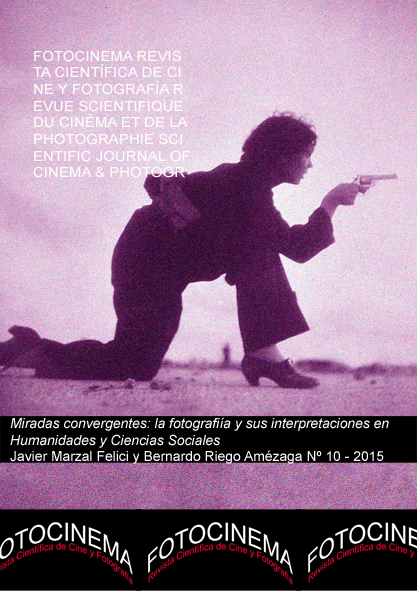La fotografía se hace al andar: Bernard Plossu y el paisaje español
DOI:
https://doi.org/10.24310/Fotocinema.2015.v0i10.5985Abstract
Resumen:
Desde 1987, el fotógrafo francés Bernard Plossu (Dalat, Vietnam, 1945) se interesa por el paisaje español. Perdiéndose por el desierto de Almería o mirándolo por la ventanilla del tren, su relación al paisaje es una constante de su obra. Este artículo se centra en unos encargos que recibió a partir de 2007, en el Norte de Aragón y en la Sierra de Albarracín; lo completamos con un reciente trabajo suyo, en color, sobre los paisajes del Alt Empordà. Basada en una intimidad que logra alcanzar tras horas de caminar, tras horas de adentrarse en los montes de Aragón o al recorrer las costas rocosas de Port-Lligat, sus fotografías conservan la huella de aquella fusión del hombre con el territorio, a modo del arquero zen que se confunde con el blanco: el paisaje se ha vuelto interior
Abstract:
Since 1987, the French photographer Bernard Plossu (Dalat, Vietnam, 1945) was interested in the Spanish landscape. Being lost in the desert of Almeria or watching it through the window of the train, his relationship to the landscape is a constant in his work. This article focuses on a few errands that he received from 2007, in the North of Aragon and the Sierra Albarracin; our article ends with one of his recent work, in colour, about the landscapes of the Alt Empordà. Based on a intimacy reached after many hours of walking, or hiking in the mountains of Aragon or touring around the rocky shores of Port-Lligat, his photographs preserve the footprint of the fusion of man with the territory, as the Zen archer mingles with the white: the landscape has become interior.
Palabras clave:Bernard Plossu; paisaje; Aragón; Albarracín; Alt Empordà; ética del caminar.
Keywords:
Bernard Plossu; Landscape; Aragon; Albarracin; Alt Empordà; Ethics of the WalkDownloads
Metrics
Publication Facts
Reviewer profiles N/A
Author statements
Indexed in
-
—
- Academic society
- N/A
- Publisher
- Universidad de Málaga
Downloads
Published
How to Cite
Issue
Section
License
All contents published in Fotocinema Revista científica de cine y fotografía are protected under the Creative Commons Attribution-NonCommercial-ShareAlike 4.0 International (CC BY-NC-SA 4.0) license. All about this license is available in the following link: <http://creativecommons.org/licenses/by-nc-sa/4.0>
Users can copy, use, redistribute, share and exhibit publicly as long as:
- The original source and authorship of the material are cited (Journal, Publisher and URL of the work).
- It is not used for comercial purposes.
- The existence of the license and its especifications are mentioned.
There are two sets of authors’ rights: moral and property rights. Moral rights are perpetual prerogatives, unrenounceable, not-transferable, unalienable, imprescriptible and inembargable. According to authors’ rights legislation, Fotocinema. Revista científica de cine y fotografía recognizes and respects authors moral rights, as well as the ownership of property rights, which will be transferred to University of Malaga in open access. The property rights are referred to the benefits that are gained by the use or the dissemination of works. Fotocinema. Revista científica de cine y fotografía is published in an open access form and it is exclusively licenced by any means for doing or authorising distribution, dissemination, reproduction, , adaptation, translation or arrangement of works.
Authors are responsable for obtaining the necessary permission to use copyrighted images.














13.png)



